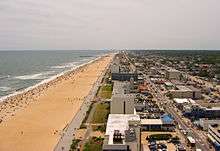False Cape State Park
False Cape State Park is a 4,321-acre (17.49 km2) state park located on the Currituck Banks Peninsula, a one-mile-wide (1.6 km) barrier spit between the Back Bay of the Currituck Sound and the Atlantic Ocean, within the city of Virginia Beach, adjacent to the state border with North Carolina, and just north of Mackay Island National Wildlife Refuge.
| False Cape State Park | |
|---|---|
IUCN category IV (habitat/species management area) | |
 | |
 Location within Virginia | |
| Location | Virginia, United States |
| Nearest city | Virginia Beach, VA |
| Coordinates | 36°35′16″N 75°53′3″W |
| Area | 4,321 acres (17.49 km2) |
| Established | 1966 |
| Governing body | Virginia Department of Conservation and Recreation |
False Cape State Park includes hiking and biking trails, a visitors' center, environmental educational and primitive camping facilities. The park can be accessed from the north on foot, bicycle, or seasonally available tram through Back Bay National Wildlife Refuge, or from the south on foot or bicycle. Boat access is possible from any shoreline. Limited beach vehicular access remains for grandfathered permit holders.
History
The park is named False Cape because from the ocean it could be easily mistaken for Cape Henry, which lies about 20 miles (32 km) to the north at the mouth of the Chesapeake Bay.[1] Ships and boats looking for Cape Henry instead sailed into the shallow waters, where they could easily run aground.
The community of Wash Woods, now abandoned, was developed by survivors of such a shipwreck in the 17th or early 18th century.[2] The village's church and other structures were built using cypress wood that washed ashore from a wreck. In the early 20th century, False Cape was a haven for a number of hunt clubs taking advantage of the area's abundant waterfowl. The park's Wash Woods Environmental Education Center is a converted hunt clubhouse.[3]
Undeveloped portions of the park were dedicated as the False Cape Natural Area Preserve in 2002.[4]


At the south end of False Cape is a monument with "Va." on one side and "N Ca" on the other. Although it reads "A.D. 1728" on the top, it was more likely erected in 1887 when the boundary was surveyed again, since the original marker was a simple cedar post. "A.D. 1728" refers to the year the current boundary was first surveyed.[5]
See also
- Wash Woods
- Virginia Beach, Virginia
- Back Bay National Wildlife Refuge
- Former counties, cities, and towns of Virginia
References
- "False Cape State Park". StateParks.com. Retrieved 13 April 2016.
- "Wash Woods - Yahoo! Voices". voices.yahoo.com. Archived from the original on 2012-07-17. Retrieved 2012-02-03.
- "Orbitz Travel: Vacations, Cheap Flights, Airline Tickets & Airfares". Retrieved 26 May 2016.
- "False Cape Natural Area Preserve". Virginia Department of Conservation and Recreation. Retrieved December 18, 2016.
- "Virginia-North Carolina Boundary". Retrieved 26 May 2016.
External links
| Wikimedia Commons has media related to False Cape State Park. |
- False Cape State Park
- Waterland Farm website with photos of remains of Wash Woods
- Museumsusa.org, False Cape State Park webpage
- VirginiaBeach.com
| Preceded by Sandbridge, Virginia Beach |
Beaches of The Outer Banks | Succeeded by Currituck Beach |
